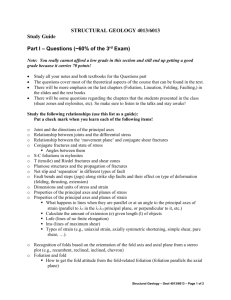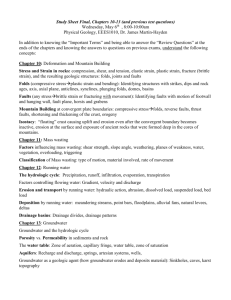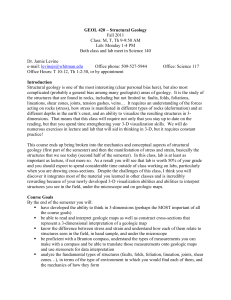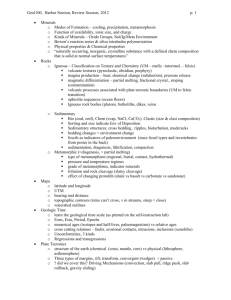recent course syllabus
advertisement
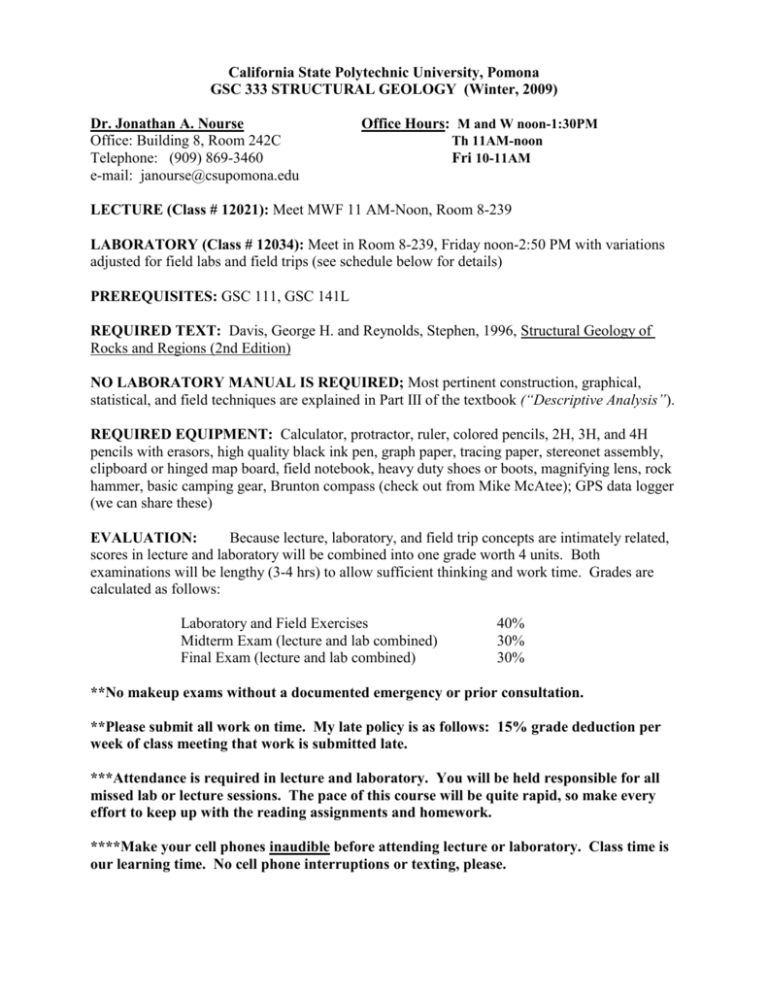
California State Polytechnic University, Pomona GSC 333 STRUCTURAL GEOLOGY (Winter, 2009) Dr. Jonathan A. Nourse Office: Building 8, Room 242C Telephone: (909) 869-3460 e-mail: janourse@csupomona.edu Office Hours: M and W noon-1:30PM Th 11AM-noon Fri 10-11AM LECTURE (Class # 12021): Meet MWF 11 AM-Noon, Room 8-239 LABORATORY (Class # 12034): Meet in Room 8-239, Friday noon-2:50 PM with variations adjusted for field labs and field trips (see schedule below for details) PREREQUISITES: GSC 111, GSC 141L REQUIRED TEXT: Davis, George H. and Reynolds, Stephen, 1996, Structural Geology of Rocks and Regions (2nd Edition) NO LABORATORY MANUAL IS REQUIRED; Most pertinent construction, graphical, statistical, and field techniques are explained in Part III of the textbook (“Descriptive Analysis”). REQUIRED EQUIPMENT: Calculator, protractor, ruler, colored pencils, 2H, 3H, and 4H pencils with erasors, high quality black ink pen, graph paper, tracing paper, stereonet assembly, clipboard or hinged map board, field notebook, heavy duty shoes or boots, magnifying lens, rock hammer, basic camping gear, Brunton compass (check out from Mike McAtee); GPS data logger (we can share these) EVALUATION: Because lecture, laboratory, and field trip concepts are intimately related, scores in lecture and laboratory will be combined into one grade worth 4 units. Both examinations will be lengthy (3-4 hrs) to allow sufficient thinking and work time. Grades are calculated as follows: Laboratory and Field Exercises Midterm Exam (lecture and lab combined) Final Exam (lecture and lab combined) 40% 30% 30% **No makeup exams without a documented emergency or prior consultation. **Please submit all work on time. My late policy is as follows: 15% grade deduction per week of class meeting that work is submitted late. ***Attendance is required in lecture and laboratory. You will be held responsible for all missed lab or lecture sessions. The pace of this course will be quite rapid, so make every effort to keep up with the reading assignments and homework. ****Make your cell phones inaudible before attending lecture or laboratory. Class time is our learning time. No cell phone interruptions or texting, please. TENTATIVE LECTURE AND LABORATORY SCHEDULE: (Pertinent reading from text is in bold italics below) Week 1 (January 5, 7, 9): Course Logistics; Photographic examples of geologic structures Introduction to three types of structural analysis (Dynamic, Kinematic, and Descriptive); Primary vs. Secondary geologic structures; Chapter 1; Start Reading Descriptive Analysis (Part III) Laboratory #1 (at Cal Poly): Fundamental construction techniques; Construction of geologic cross sections; Interpretation of geologic maps; The classic 3-point problem; Strike, Dip, and the Rule of V’s; Projection of dipping contacts across canyons; p. 669-673; p. 684-691 Week 2 (January 12, 14, 16): Geologic structures formed at different crustal levels in extensional, compressional and strike-slip tectonic environments; p. 626-669 Lab #2 (Friday, January 16, 11AM –3PM): Field Exercise--measurement of dikes, foliation, faults and fault striations in San Antonio Canyon Week 3 (January 21, 23): Stereographic projection and stereonet plotting techniques; Three dimensional stress states and resulting brittle deformation; Joints, shear fractures, faults, and fault striations; dikes and dike swarms; p.691-708, Chapter 3; Chapters 5-6 **Monday, January 19 is a University Holiday** Lab #3 (Friday, January 23, at Cal Poly): The Mohr stress circle and applications to earthquake faulting, Rock mechanics and related experiments Week 4 (January 30): Anderson-Coulomb fault-fracture theory; (focus reading on p.301315, p.717-730) **Lecture will not meet Monday, January 26 or Wednesday, January 28—Use free time to finish up Lab #2** Friday, January 30 at Cal Poly—extended lecture; finish up Lab#3 Week 5 (February 2, 4, 6): Ductile strain and the strain ellipsoid; Geometric relationship to Foliation (cleavage, schistosity, gneissosity, etc) and Stretching Lineation; L-Tectonites, STectonites, and L-S Tectonites; Coaxial strain Chapter 2; Chapter 8 Lab #4 (Friday noon, Feb 6 through Sunday early PM, Feb 8): Weekend Field Trip (location and topic dependent on prevailing weather conditions) Week 6 (February 9, 11, 13): Monday, Feb 9: Natural strain markers and techniques of strain analysis Lab #5 at Cal Poly assigned Wednesday, Feb 11: Strain analysis--measurement of stretched pebbles; quantification of strain parameters (longitudinal strain and shear strain) Midterm Exam—to be completed between Wednesday PM, February 11 and Friday PM, February 13 2--allow 3-4 hours Week 7 (February 16, 18) Introduction to Richard Allmendinger’s StereoWin plotting program; Noncoaxial strain and shear strain; Pure shear vs. simple shear; related equations Begin reading Chapter 9 **Friday, February 20 is a University Holiday** Week 8 (February 23, 25, 27): Noncoaxial brittle-ductile deformation zones (Shear Zones) and Associated rock fabrics: breccias, mylonites, foliation and lineation; Meso and microscopic S-C fabrics; Buckling and boudinage of dikes and sills in shear zones Chapter 9; p.737 Lab #6 (Friday noon, Feb 27 through Sunday PM, March 1): Weekend Field Trip (location and topic dependent on prevailing weather conditions) Week 9 (March 2, 4, 6): Begin general topic of Folds: Description, classification, and associated lineation; Relationship of folds to local and regional strain fields; Chapter 7 Lab #7 (Friday, Nov 9: Quantitative shear zone analysis using hand specimens and thin sections Week 10 (March 9, 11, 13): Folds continued: Bedding/cleavage relations in folded terrain; flexural slip folding and S, Z, W, M folds; Stereographic representation of various fold geometries; Exploration techniques: projecting folds into the subsurface Chapter 7; p. 388391; p.730-736 Lab #8 (Friday, March 13, noon to 3PM) 3: measurement of local folds ** Final Examination may be taken between Monday March 16 and Thursday, March 19 at a mutually agreeable time—allow 3-4 hours** Learning Outcomes: Upon completion of this course, students shall have attained working knowledge of content areas and developed practical skills as listed below: 1. Understand the rule of V’s as applied to interaction of topography with variably oriented rock layers 2. Construct true scale geologic cross sections from a geologic map base 3. Recognize, describe, and accurately measure various classes of geologic structures (including bedding, unconformities, intrusive contacts, faults, fault striations, foliation, lineation, folds, fold hinges, axial planes, etc.) in their natural field setting 4. Plot various types of structural orientation data on a stereonet diagram 5. Interprete the 3-dimensional geometry of structures plotted on stereonet diagrams 6. Understand geometric relationships between three main classes of faults and orientations of the principle stresses 7. Apply the strain ellipsoid concept to measurement and interpretation of 3-dimensional strain in naturally deformed rock masses 8. Utilize drawings of progressive deformation to illustrate fundamental differences between coaxial plane strain (pure shear) and noncoaxial plane strain (simple shear) 9. Understand Mohr-Coulomb theory of rock failure and its application to earthquake faulting 10. Recognize and describe various classes of kinematic indicators associated with ductile shear zones 11. Classify fold geometries in terms of inter-limb angle and orientations of hinges and axial planes. 12. Relate the concept of cylindrical folding to stereonet representations of structures associated with folded surfaces 13. Understand geometric relationships of S folds, Z folds, W folds, M folds, and axial plane cleavage/foliation to larger scale folds in folded terrain
